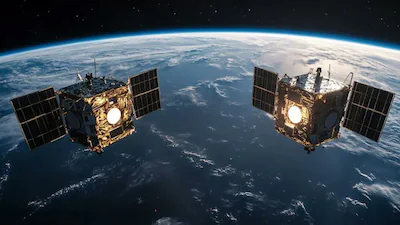
Why in news:-On January 16, 2025, the Indian Space Research Organisation (ISRO) achieved milestone in space exploration by successfully docking two satellites, SDX01 and SDX02.
Docking and De-docking in Space
Understanding Docking and De-docking
Docking is the process of two spacecraft connecting in space, requiring precise coordination of speed and orientation. While de-docking might seem simpler, it is equally intricate. A controlled separation is essential to prevent unintended drift in microgravity, where even the smallest force can cause significant movement.
Challenges of De-docking
De-docking involves more than just detaching spacecraft. It requires a careful release of latches and hooks, often executed remotely. If a pressurized tunnel connects the spacecraft, it must be decompressed safely before separation. Ensuring a low-force disengagement is crucial to maintaining stability and preventing damage.
Significance for Future Missions
ISRO’s advancements in docking and de-docking pave the way for future space missions. These include Chandrayaan-4, which aims to return lunar samples, and Gaganyaan, India’s first crewed spaceflight. Mastering docking technology is also vital for in-space refueling, a capability that can extend satellite lifespans and reduce the frequency of new launches.
The SpaDex Mission
The SpaDex mission, launched on December 30, 2024, demonstrated space docking technology using two small satellites, SDX01 and SDX02. The mission was carried out using the Polar Satellite Launch Vehicle (PSLV), marking a significant milestone in India’s space technology development.
Upcoming Experiments and Future Plans
ISRO is set to conduct further experiments starting March 15, 2025. The unified satellite remains in an elliptical orbit, providing a limited window for experiments every two months. These continued tests will refine docking capabilities and contribute to the success of future space missions.
